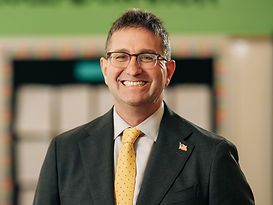GUEST COLUMN.
BUILDING CAPACITY FOR CROSS-SECTOR COLLABORATION
By Michael Welker Director of Policy and Research Partnerships, ncIMPACT Initiative, University of North Carolina School of Government

Communities across the country are facing deeply complex and intertwined challenges, from affordable housing to educational attainment to mental and behavioral health. These “wicked problems” are not limited by organizational, sectoral, or jurisdictional lines. Government professionals – and many other stakeholders – understand that community leaders must work across these lines strategically to address their biggest challenges.
But while the need for cross-sector collaboration is well understood, many communities struggle with how to approach the process. It may not always be clear where a cross-sector collaborative effort should begin, who should be involved, and how the work should be organized and sustained.
In our work at the ncIMPACT Initiative of the UNC School of Government, we help entities deal with these types of questions frequently. For nearly a century, within North Carolina, the School of Government has been a trusted resource to the state’s local governments helping counties and municipalities navigate the complexities of local government law, finance, and management. ncIMPACT has built on this tradition by widely sharing high quality research and data about larger social and economic trends shaping North Carolina and partnering with local civic leaders to test creative approaches to take on these issues.
This work has led us to a model of cross-sector collaboration that provides communities with a replicable framework to build, accelerate, and sustain community collaboratives, and I believe it could serve as a model for other states.
We call our approach Community Sync. It draws on other leading frameworks like Collective Impact, Strategic Doing, and systems change but has been refined through our experiences partnering directly with local communities to develop cross-sector collaboratives.
In each of ncIMPACT’s cohort-based programs, community leaders convene relevant stakeholders who are committed to addressing a shared complex challenge. ncIMPACT then helps each community team create the structures required to succeed, from setting a vision and goals to building out an action plan to evaluating the work and ultimately to planning for the collaborative’s long-term sustainability.
Along the way, we help teams identify high-quality evidence and information about potential strategies from other partners at the School of Government, UNC, and across North Carolina and the nation. Ultimately, the communities lead, creating their own frameworks for change and selecting the strategies that make sense for their own unique local contexts.
Since 2018, we have extended this approach across six cohorts of communities. These programs have included:
The Opioid Response Project (2018-20): 10 community teams focused on addressing the opioid crisis.
Local Educational Attainment Collaboratives (2021-2022): 15 community teams dedicated to raising postsecondary attainment rates.
Our State, Our Work (2021-2023): 13 community teams aimed at reengaging Opportunity Youth in educational and workforce programs.
Our State, Our Wellbeing (2023-2024): 15 community teams working to prevent suicide.
Our State, Our Homes (2025-2026): 14 community teams pursuing strategies to address housing affordability.
CARE4Youth (2025-2028): 10 community teams committed to improving youth mental health outcomes.
Across these programs, the outcomes have been remarkable. Hundreds of organizational partners have come together in local collaboratives, and the programs and services they have delivered have reached tens of thousands of North Carolinians. The dozens of collaboratives we have worked with to date have achieved success not just across issue areas but across geographies, as our cohorts have represented a total of 79 of North Carolina’s 100 counties – from urban to rural, mountains to coast, and everything in between.
These experiences have taught us that cross-sector collaboration is a competency that can be learned and practiced by communities, but it requires a set of skills among leaders to optimize the chance of success. This collaborative form of leadership is distinct from leadership within single organizations, where goals, team structures, and available resources may be more clearly defined. Instead, successful collaborative leaders must be able to understand the interests and perspectives of stakeholders across a system, facilitate consensus around shared priorities among partners, and continually engage and galvanize community members to contribute to the work.
For government practitioners, this work also involves understanding how their organizations can create conditions for a cross-sector collaborative to thrive. Decisions around policy, budgets, programs, and services often create opportunities to launch a cross-sector collaborative or pathways to ensure impact is meaningful and sustainable.
Government organizations often possess the resources, relationships, and knowledge necessary for a cross-sector collaborative to succeed. Their involvement can lend authority and credibility to collaborative efforts. But governments benefit from their participation too, as collaborative partners may have their own resources to offer, close relationships to community members, or flexibility that a government organization might not have.
We make no promises that the process is easy, and, in fact, we encourage communities to embrace the reality that building collaboration across sectors can often be a messy, nonlinear, and uncomfortable process. We believe that cross-sector collaboration should be used only when necessary and only with the requisite commitment from a wide range of local stakeholders. In those cases, however, the promise is great.
In the face of ever-shifting pressures and challenges for our communities, we must equip local leaders – especially those in government – with the tools, capacity, and confidence to lead and actively participate in cross-sector community collaboratives. Models like Community Sync show that with the right support, effective cross-sector collaboration to tackle complex challenges is not just possible: it’s replicable, scalable, and transformative.
The contents of this Guest Column are those of the author, and not necessarily Barrett and Greene, Inc.
#StateandLocalGovernmentManagement #StateandLocalGovernmentPerformance #LocalGovernmentCommunityCollaboration #StateandLocalInnovation #CollaborativeCommunityinnovation #CommunitySync #ncImpact #NcImpactCommunitySyncGuestColumn #WickedProblemCollaboration #StateandLocalCrossSectorCollaboration #UNCSchoolOfGovernment #UNCSchoolOfGovernmentCollaborationInitiative #CollaboratingOnCommunityChallenges #NorthCarolinaCommunitySyncCollaboration #LocalGovernmentStakeholderCollaboration #CommunityLedFrameworkForChange #CommunityStakeholderCommitment #BuildingCapacityForCrossSectorCollaboration #StateandLocalGovernmentCommunityCollaboration #CrossSectorCollaborationModel #CommunityCollaborationImpact #CollaborativeCommunityOutcomes #NorthCarolinaInnovation #MichaelWelker #BandGGuestColumn #BarrettandGreeneInc



































































































